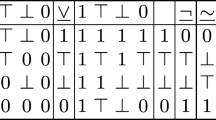Abstract
We introduce a Gentzen style formulation of Basic Propositional Calculus(BPC), the logic that is interpreted in Kripke models similarly tointuitionistic logic except that the accessibility relation of eachmodel is not necessarily reflexive. The formulation is presented as adual-context style system, in which the left hand side of a sequent isdivided into two parts. Giving an interpretation of the sequents inKripke models, we show the soundness and completeness of the system withrespect to the class of Kripke models. The cut-elimination theorem isproved in a syntactic way by modifying Gentzen's method. Thisdual-context style system exemplifies the effectiveness of dual-contextformulation in formalizing various non-classical logics.
Similar content being viewed by others
References
Aghaei, M. and Ardeshir, M., 2000, “A bounded translation of intuitionistic propositional logic into basic propositional logic,” Mathematical Logic Quarterly 46, 199–206.
Aghaei,M. and Ardeshir, M., 2001, “Gentzen-style axiomatizations for some conservative extensions of basic propositional logic,” Studia Logica 68, 263–285.
Ardeshir, M., 1995, “Aspects of basic logic,” Ph.D. Thesis, Marquette University, Milwaukee.
Ardeshir, M. and Ruitenburg, W., 1998, “Basic propositional calculus I,” Mathematical Logic Quarterly 44, 317–343.
Ardeshir, M. and Ruitenburg, W., 2001, “Basic propositional calculus II. Interpolation,” Archive for Mathematical Logic 40, 349–364.
Barber, A., 1997, “Linear type theories, semantics and action calculi,” Ph.D. Thesis, LFCS, University of Edinburgh.
Bierman, G.M. and de Paiva, V.C.V., 2000, “On an intuitionistic modal logic,” Studia Logica 65, 383–416.
Davies, R. and Pfenning, F., 1996, “A modal analysis of staged computation,” pp. 258–270 in Proceedings of the 23rd Annual Symposium on Principles of Programming Languages, St. Petersburg Beach, FL, G. Steele, Jr., ed., New York: ACM Press.
Gentzen, G., 1935, “Untersuchungen über das logische Schliessen,” Mathematische Zeitschrift 39, 176–210, 405–431. English translation: pp. 68–131 in The Collected Papers of Gerhard Gentzen, M.E. Szabo, ed., Amsterdam: North-Holland.
Girard, J.-Y., 1993, “On the unity of logic,” Annals of Pure and Applied Logic 59, 201–217.
Heuerding, A., Seyfried, M., and Zimmermann, H., 1996, “Efficient loop-check for backward proof search in some non-classical propositional logics,” pp. 210–225 in Proceedings of Theorem Proving with Analytic Tableaux and Related Methods, 5th International Workshop, TABLEAUX’ 96, Terrasini, Palermo, Italy, P. Miglioli, U. Moscato, D. Mundici, and M. Ornaghi, eds., Lecture Notes in Artificial Intelligence, Vol. 1071, Berlin: Springer-Verlag.
Hodas, J.S. and Miller, D., 1994, “Logic programming in a fragment of intuitionistic linear logic,” Information and Computation 110, 327–365.
Ishii, K., Kashima, R., and Kikuchi, K., 2000, “Sequent calculi for Visser's propositional logics,” Notre Dame Journal of Formal Logic, to appear.
Kikuchi, K., 2002, “Dual-context sequent calculus and strict implication,” Mathematical Logic Quarterly 48, 87–92.
Masini, A., 1992, “2-Sequent calculus: A proof theory of modalities,” Annals of Pure and Applied Logic 58, 229–246.
Ruitenburg, W., 1999, “Basic logic, K4, and persistence,” Studia Logica 63, 343–352.
Sasaki, K., 1998, “A Gentzen-style formulation for Visser's propositional logic,” Nanzan Management Review 12, 343–351.
Sasaki, K., 1999, “Formalizations for the consequence relation of Visser's propositional logic,” Reports on Mathematical Logic 33, 65–78.
Suzuki, Y., Wolter, F., and Zakharyaschev, M., 1998, “Speaking about transitive frames in propositional languages,” Journal of Logic, Language and Information 7, 317–339.
Szabo, M.E., ed., 1969, The Collected Papers of Gerhard Gentzen, Amsterdam: North-Holland.
Visser, A., 1981, “A propositional logic with explicit fixed points,” Studia Logica 40, 155–175.
Wansing, H., 1997, “Displaying as temporalizing, sequent systems for subintuitionistic logics,” pp. 159–178 in Logic, Language and Computation, S. Akama, ed., Dordrecht: Kluwer Academic Publishers.
Author information
Authors and Affiliations
Rights and permissions
About this article
Cite this article
Kikuchi, K., Sasaki, K. A Cut-Free Gentzen Formulation of Basic Propositional Calculus. Journal of Logic, Language and Information 12, 213–225 (2003). https://doi.org/10.1023/A:1022363219134
Issue Date:
DOI: https://doi.org/10.1023/A:1022363219134




